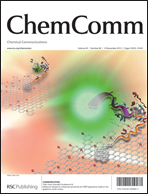Surface control of blastospore attachment and ligand-mediated hyphae adhesion of Candida albicans†
Abstract
Adhesion on a surface via nonspecific attachment or multiple ligand–receptor interactions is a critical event for fungal infection by Candida albicans. Here, we find that the tri(ethylene glycol)- and D-mannitol-terminated monolayers do not resist the blastospore attachment, but prevent the hyphae adhesion of C. albicans. The hyphae adhesion can be facilitated by tripeptide sequences of arginine–glycine–aspartic acid (RGD) covalently decorated on a background of tri(ethylene glycol)-terminated monolayers. This adhesion mediated by selected ligands is sensitive to the scrambling of peptide sequences, and is inhibited by the presence of cyclic RGD peptides in the solution.


 Please wait while we load your content...
Please wait while we load your content...